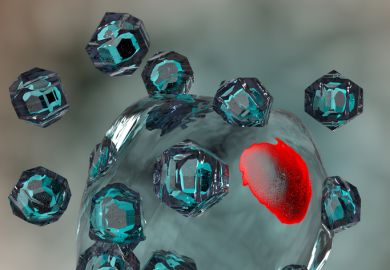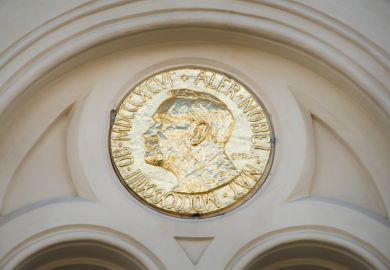Matter has always been a problem, and despite the ferretings of chemists and physicists remains one still. What exactly is it? What do we touch when we touch? What are we made of? What, deeply, deeply, is a tangible thing?
Chemists have struggled with these questions for several thousand years, or several hundred if we discount the alchemists, and have provided a temporary way-station of an answer by identifying the hundred or so chemical elements from which everything tangible is made. The physicists have built their way-station further out, and have taught the chemists that their elements are not particularly elementary, and that the elementary particles are more fundamental. But even quarks are perhaps only half an answer to the ultimate question.
Paul Strathern traces the search for the chemists' answer right back to Thales of Miletus, who 2,500 years ago looked for the element that lay at the root of all matter, and identified it as water. At least it was a beginning of rational thought. As they have done to so much of Greek philosophy, subsequent ages have added encrustation rather than elucidation, and Empedocles, who suggested an elaboration to four elements - air, fire, earth, and water - was responsible perhaps more than anyone for shackling chemistry to an error that was to persist for 2,000 years. But there were extraordinarily insightful contributions, as also marked the Greeks, and well before there was any evidence Leucippus proposed what ultimately would prove to be the currency of discourse of modern chemistry,the existence of atoms.
In Alexandria, rational thought, as exemplified by the Greeks, met practical skills, as exemplified by the Egyptian experience of burying their dead, and from the conjunction alchemy emerged. Its origins condemned it to the realm of sorcery right from the beginning, and driven as it was in part by the quest for riches both temporal (gold) and spiritual (immortality), alchemy was destined for the underground of the intellect. There it remained for two millennia. Strathern ponders how it could have got away with it for so long, and identifies its obscure language and arcane symbolism that made it impenetrable to thoughtful folk.Some of us cannot help reflecting that religion has a similar history and similar reasons for its persistence. The only difference appears to be that at least one pope, Pope John XXII, tried to ban alchemy (in 1317), perhaps in a fit of pique when he found it did not work.
Happily, the library at Constantinople burned to the ground in 1204, and with it went the recorded nonsense of centuries. Mankind had to start afresh, and from experiment rather than authority there started to emerge reliable knowledge. The bombastic, drunken Theophrastus Bombast von Hohenheim, Paracelsus to history, brought a certain pragmatism to bear at the end of the 15th century, and had the insight to regard a human body as no more than an elaborate chemical laboratory. Then controlled experiment began to bring fresh air, of a kind, to the study of matter and the great names of the subject begin to emerge, such as Boyle and later Dalton and Lavoisier. Newton, a great dabbler in the mystic art, wasted half his life in the pursuit of daft ideas.
Perhaps the greatest leap forward, the leap that wrenched chemistry from alchemy, and switched attention from qualities to quantitatively measurable properties, was the introduction of the chemical balance and its deployment by Lavoisier. Numbers could at last be attached to matter and the rigour of measurement would ensure reliable progress. Soon, too, new and more potent stimulation could be applied to matter to shake it apart, and new elements came tumbling forth from compounds. Lavoisier himself discovered none, but with electrolysis applied to matter the 23 elements he knew grew to nearly 60 by the middle of the 19th century.
That number was enough for fruitful dreaming. Patterns began to emerge. First Johann Wolfgang Dobereiner discovered triads of elements that had weights that formed a pattern and, astonishingly, properties too. Then John Newlands found more extended patterns, and found octaves of elements. There the matter rested until Mendeleyev was confronted with the problem of organising the presentation of the elements for the textbook he was preparing. Intense thought founded on wide experience, and his pastime of patience, finally led him, apocryphally at least, to emerge from his dream with the elements organised in the pattern that hangs on every laboratory wall and is the basis of the presentation of chemistry in all the books. Strathern has done a thoroughly good job in organising this essential component of our intellectual history and presenting it as a lively tale.
One of the pivotal moments in this journey from alchemy to chemistry was the discovery in about 1670 of a new element after a dark age of centuries.That element, the 13th to be identified and the first element to be discovered (but not recognised as such) since the Middle Ages, was phosphorus. And what an element it turned out to be! John Emsley, who was himself brought up on the study of its chemical wiles, has written an engaging biography of this two-faced member of the periodic table. He traces its discovery by Hennig Brandt in Hamburg, who as an alchemist sought gold from more or less anything golden. Thus, urine and sand were candidates for scrutiny, and chemists of the day thought nothing of working on fermented urine mixed with sand if that was the route to wealth.
Emsley's theme is that phosphorus has brought both salvation and destruction to the world. Because of its seemingly magical glow (which we now know to be due to the slow formation of chemiluminescent oxides) phosphorus was used indiscriminately as a cure-all, proving in the process to be a kill-all. Yet phosphorus is also at the heart of the energy chain in every living cell, and without it no organism can survive. Careful chemical deployment of the element thus leads on the one hand to nerve gases and on the other to fertilisers that sustain the stress of modern human populations.
Perhaps Emsley tells us more than we ever wanted to know about a single element; but his story reveals the unconscious personality of an element, one of 100 personalities that Mendeleyev was able to arrange in his table.
Peter Atkins is professor of chemistry, University of Oxford.
The Shocking History of Phosphorus
Author - John Emsley
ISBN - 0 333 76638 5
Publisher - Macmillan
Price - £12.99
Pages - 326
Register to continue
Why register?
- Registration is free and only takes a moment
- Once registered, you can read 3 articles a month
- Sign up for our newsletter
Subscribe
Or subscribe for unlimited access to:
- Unlimited access to news, views, insights & reviews
- Digital editions
- Digital access to THE’s university and college rankings analysis
Already registered or a current subscriber? Login



